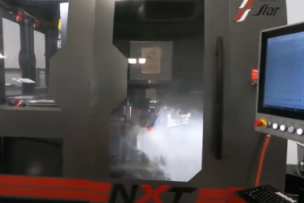If you are struggling to keep pace with today’s innovations in computer-aided design and computer-aided manufacturing, here’s a guide from an industry expert to help you sort through the fine print.
Are you unable to take on new work because your CAM or CAD/CAM systems are outdated or you have heard things can be faster and more productive (but may require an investment you are not sure you can afford to make)?
The bigger question, however, just might be: Can you afford not to?
Maybe your shop bought a CAM package to help program its first machining center, but now that software is 10 years old. Perhaps you’ve tried more programming systems than you care to admit. Or maybe you’re still programming by hand.
How a CAD/CAM System Can Help Your Manufacturing
There are some excellent productivity-based reasons to invest in or upgrade to a modern CAM system or expand into a full-blown CAD package with integrated CAM functionality. With the expansion of CAD/CAM cloud services, you may not have to own the system all yourself.
1. Manufacturing Efficiency
Today’s CAM systems offer greater efficiency in a number of ways. First, you’re going to spend less time programming or, better yet, generate more programs in the same amount of time.
CAM functions such as feature recognition, toolpath wizards and experts, and simultaneous axis synchronization are a few of the tools that reduce screen time and make toolpaths more consistent. These capabilities also make it easier for less experienced programmers to step in, freeing up others for more challenging work.
Secondly, and perhaps more importantly, a modern CAM system leverages high-efficiency machining techniques such as trochoidal milling and chip thinning. According to many industry experts, adopting these practices can reduce cycle times by 90 percent or more, often without having to invest in a high-end machine tool.
2. Capabilities
Again, there are several considerations. The first is obvious: If you started out with a system well-suited for 3-axis milling but now have a shop filled with 5-axis machining centers, it’s probably time to evaluate a new system.
The same goes for multitasking machines, wire electrical discharge machining and Swiss-style lathes. Even if an older system supports these advanced technologies, will it help you get the most out of your machine tool investment? You will need to take a look at the CAD side of the equation.
Most CAM systems have at least rudimentary drawing and modeling capabilities, needed for fixture design and tweaking part models during programming. That might not be enough. Customer CAD files are not always perfect, and some customers want suppliers that can support their design efforts.
In either case, a fully functional CAD system (one with robust, integrated CAM capabilities) will improve programming efficiency and open doors to additional revenue.
3. Functionality
No CAD/CAM package can stand on its own. Smart shops use cloud-based tool libraries, offline presetters, tool management systems and company-wide enterprise resource planning, or ERP, software.
If your programming tools can’t interface with these systems, you’re facing duplicate data entry, loss of visibility and increased chance of expensive errors. Further, a number of the latest toolpath simulation and optimization tools can make a good CNC program much better, while reducing setup times and virtually eliminating the chance of a crash. You’ll want to make sure that your current system plays nice with these tools.
CAD/CAM System Evaluation Period: Demo with Your Parts
If you’re convinced that your shop might benefit from better design tools and programming functionality, where do you start? After all, everyone claims to have the easiest-to-use system, the most productive toolpaths and the best support. A demo will make them prove it.
Start by educating yourself. Learn what CAD/CAM attributes are available and prioritize those that are most important to your shop. Talk to others doing similar work, and find out what they like or don’t like about their current systems.
Once you’ve narrowed down the list of potential suppliers, schedule demos using your parts. This is important because it provides an apples-to-apples baseline against which to measure all the systems you will consider.
If you have the machine time available, cut the test part on your machine using the vendor’s code.
The Importance of a CAM Postprocessor
If you have the machine time available, cut the test part on your machine using the vendor’s code, although this might depend on the availability of a suitable postprocessor.
The postprocessor—the part of the CAM system that actually spits out the machine code—can make or break the deal. Be sure that you can modify it as needed for your unique mix of machine tools or that the software maker can tackle this task for you successfully.
Trust goes both ways: Shops that let their CAD/CAM maintenance agreements lapse are doing themselves and their suppliers a disservice. Always budget for software maintenance, and keep systems updated. (One version behind is OK, if you don’t like the bleeding edge).
Leveraging Cloud Technology to Reduce CAD/CAM System Costs
If you’re worried about the high cost of CAD/CAM along with the annual support contract, there’s good news: These costs are a drop in the bucket compared to low-machining efficiency, scrap parts and machine downtime.
Luckily, an increasing number of CAD/CAM providers now offer low-cost, subscription-based packages, many of which are available as cloud services.
Not only does the cloud free up the need for an upfront capital investment, it provides more ability to scale up quickly if new work comes in. It can also reduce ongoing technology costs by reducing licenses and systems that sit idle while assuring that you maintain the latest and greatest software releases.
What advantages have new CAD/CAM systems given your shop? Comment here.




Talk to Us!
This is Charles Ellis. I would like to make an inquires
about the price of the under listed product in your reputable company,
kindly get back to me with pricing and advice us on the inventory
availability.
Product List:
*Intel Core i7-6700K 4GHz Quad-Core Processor - 8MB BX80662176700K
*WS-C2960-24PC-L Cisco Catalyst 2960-24PC-L, Switch, Managed, 24x 10/100 (PoE) + 2x com
*STDS1000100 1TB BACKUP PLUS SLIM USB 3.0 EXT PORTABLE DRIVE
*Seagate Backup Plus Slim 4TB Portable External Hard Drive (Item ID STDR40000100)
*WDBYFT0020BBK-WESN Western Digital D My Passport 2TB Portable Hard Drive
*WDBBKD0020BBK-NESN 2TB My Passport Ultra Black
*16GB USB FLASH DRIVE
I will be waiting to read from you.
Best Regards
Charles Ellis
Strategic Procurement Partner
The University of Nottingham
Company Registration number: Rc000664
VAT Number: GB 690 391 225
King's Meadow Campus
Lenton Lane Nottingham, NG7 2NR
Phone: +44 (0) 1158715805
37HI Charles - To inquire about product pricing please contact customer service at 800-645-7270.
Thank you
24Leave a reply
Your email address will not be published. Required fields are marked *